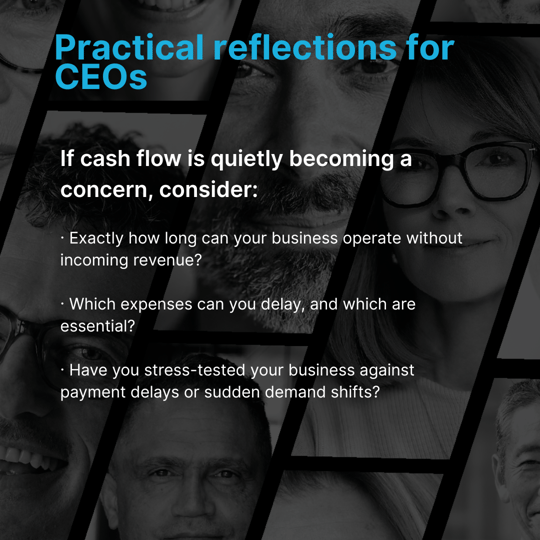Inside the cash flow squeeze catching even profitable businesses off guard.
At 3am, the world sleeps - but many CEOs and business owners lie awake. They turn over the same questions in their heads: pending invoices, looming payroll, cash coming in, but not soon enough. It’s not a competitor or missed forecast that keeps them awake. It’s cash flow.
This quiet crisis rarely makes headlines, yet it continues to impact successful Australian businesses. Research indicates cash flow issues cause 82% of global business failures. Contrary to popular belief, it’s not just startups or poorly managed SMEs that face this threat.
Mature, profitable businesses can be equally vulnerable.
“We were always focused on our profit and loss statement. But cash flow was not a regularly discussed topic. It was as if we were driving along, watching only the speedometer, when in fact we were running out of gas.”
- Michael Dell, Founder & CEO, Dell Technologies
The danger lies in the disconnect. Cash flow problems don’t look like crisis from the outside. They look like success.
Because for many CEOs, the P&L tells a story of progress: revenue trending up, customer acquisition increasing, margins holding. But cash doesn’t care about optics. It cares about timing.
Businesses go under not because they lack demand, but because they misread the rhythm of inflows and outflows. A profitable consultancy with $2 million in signed contracts can still collapse if the next receivable lands 60 days out - after payroll, rent, and the tax office have called..png?width=540&height=540&name=The%20CEO%20Series%20LI%20Carousel%20(5).png)
This vulnerability is especially pronounced in fast-growth environments and founder-led businesses. Tech startups chasing scale, wholesale operations holding inventory, or agencies billing in arrears - each one faces unique exposure to delayed liquidity. Larger enterprises may have more buffers, but they suffer their own risks: bloated receivables, overextended payment terms, and invisible cash strain that constrains agility.
Then there’s the human cost. The one that doesn’t show up on a balance sheet but plays out in boardrooms and bedrooms. Cash flow stress manifests quietly: a postponed product launch, a delayed hire, a sudden hesitance to spend on innovation. It’s the CEO running a mental triage of obligations before sunrise. The feeling of being stuck - not broken, not failing - just out of sync.
In hindsight, 2024 was a sharp reminder. Rising interest rates, tighter lending, longer payment cycles - none of it was unpredictable. Yet many businesses were caught off guard. Why? Because they over-indexed on optimism. They assumed revenue would convert to liquidity. It didn’t.
The ScotPac SME Growth Index reaffirmed what many already knew but few said aloud: cash flow remains the number one source of stress for business owners, even ahead of regulation and staffing. Xero’s Small Business Insights report showed that less than half of Australian SMEs were cash flow positive in any given month.
But this isn’t about pessimism. It’s about precision. And the good news? This is fixable.
Why 2025 Feels Different
Today’s cash flow crunch is structural rather than temporary:
- Delayed Payments: 42% of Australian businesses have renegotiated payment terms, causing disruptions in their cash cycles.
- Thin Reserves: 30% of companies lack sufficient liquidity buffers, making them vulnerable to even minor disruptions.
- Revenue Volatility: One-third of businesses grapple with unpredictable cash inflows, complicating their planning.
- Policy Ambiguity: Constant regulatory shifts create strategic uncertainty.
Xero’s “Money Matters” report highlights that over half of Australian leaders experience significant stress and anxiety due to financial uncertainty.
From Reactive Panic to Structured Calm
Businesses aren't powerless in the face of these pressures. A new breed of CEO is emerging—one who embraces liquidity management as an ongoing practice rather than a crisis response. Practical actions they’re adopting include:
- Weekly Cash Flow Check-ins: CEOs are setting weekly rituals, treating them with the same gravity as board meetings to continuously understand liquidity positions.
- Scenario Planning: Companies regularly stress-test best, worst, and realistic financial scenarios to remove the element of surprise.
- Rebalancing Terms: Leaders proactively renegotiate payment terms with suppliers and seek prepayments or deposits from customers to smooth cash flow.
- Leveraging Financial Expertise: Many businesses now opt for CFO-as-a-service, gaining high-level financial expertise without the overhead of a full-time hire.
- Real-Time Visibility: Using tools like Float, Fathom, and Xero add-ons, companies maintain an accurate, real-time picture of their financial health, not just quarterly snapshots.
These habits fix problems - and prevent them. Liquidity becomes a strategic lever rather than a trailing indicator, and the conversation shifts from “how much cash do we have?” to “what are we planning for?”
From Pressure to Advantage
Managing cash flow isn’t about panic—it’s about preparation. CEOs who build liquidity management into their leadership DNA, creating consistent routines around cash, will thrive in 2025.
The true measure of business success isn’t just earnings, but how predictably cash flows through it. Shifting conversations from panic driven “How much cash is left?” to strategic “What future are we planning for?” empowers CEOs to lead confidently.
This quiet crisis doesn’t have to end loudly—it can become an opportunity. For CEOs willing to embrace disciplined leadership, cash flow can transform from challenge into competitive advantage.




.png)